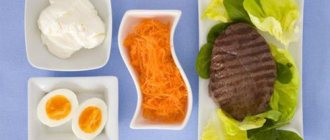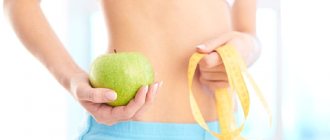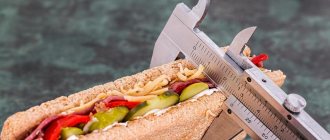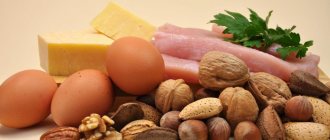Iodine content in the human body
A significant part is concentrated in the thyroid gland, it regulates metabolic processes. Kidneys and saliva are removed from the body.
Blood levels determine the time of year:
- From September to January the level is reduced.
- Since February it has been growing.
- Maximum - in May-June.
The reason for seasonal variations is unknown.
Prolonged heat treatment of products containing iodine destroys the microelement. For example:
- Meat dishes lose up to 50%.
- Vegetables – up to 30%.
- Milk – up to 25%.
Therefore, iodine deficiency in the body is possible even with sufficient intake from foods.
About iodine
Halogen was obtained in 1811 in France, but was first used by physicians in 1820.
Iodine is not produced in the body; iodine salts are supplied through diet. In case of deficiency - with specific drugs and dietary supplements.
After absorption, the bulk of the iodine salts disintegrate. The resulting iodine and iodine-containing substances are captured from the bloodstream by the thyroid gland and other organs. Under the influence of pituitary hormones, a number of thyroid hormones are synthesized in the thyroid gland. The most important of them, thyroxine, is responsible for the regulation of metabolism.
Iodine compounds are secreted by the kidneys, glands, breathing, and stomach mucous membranes.
The biological value of iodine is expressed in its action:
- regulates metabolism;
- has a positive effect on the functioning of the heart;
- participates in cellular and tissue development;
- stimulates the full development of the child’s body;
- normalizes the functioning of the nervous system;
- influences intelligence;
- helps the body cope with viral and bacterial attacks;
- regulates the absorption of certain vitamins;
- has a positive effect on the full development of the fetus in utero;
- helps lower blood cholesterol.
Iodine for the thyroid gland
Iodine-containing preparations have antibacterial, antifungal, and anti-inflammatory effects. They promote the secretion of mucus and are used to thin sputum and improve expectoration.
Iodine intake from foods is necessary for the synthesis of thyroid hormones, lowering cholesterol levels and blood clotting.
The adult thyroid gland contains up to 20–30 mg of iodine and is located on both sides of the larynx. Consists of two oval-shaped bodies weighing 15g each. With slow accumulation of the microelement, it is inactive (hypothyroidism). With excessively rapid accumulation, on the contrary, its activity is excessive (hyperthyroidism).
When products containing iodine are consumed, the thyroid gland produces hormones that regulate metabolic processes, the function of the cardiovascular and digestive systems, intellectual and sexual function.
The thyroid gland produces a special hormone-regulator of the pituitary gland, which controls the intensity of production of other hormones. The higher the level of the hormone regulator in the blood, the less intensively the thyroid gland produces other hormones.
Failure of the thyroid gland affects the course of pregnancy, the cause of miscarriage, placental abruption. Decreased and increased function disrupts the female cycle and causes infertility.
Disturbances in the functioning of the thyroid gland are the cause of mastopathy, fibroids, and prostate adenoma.
The development of hypothyroidism in children leads to mental retardation, stunted growth, disproportionate development of body parts, and delayed puberty.
Signs of hypothyroidism in adults: swelling of the mucous membranes, slow metabolism, aging of the skin, old appearance. Constant fatigue and weakness, increased risk of developing atherosclerosis.
Signs of hyperthyroidism: accelerated metabolic processes, weight loss, trembling limbs, bulging eyes, development of Graves' disease.
With insufficient intake of foods containing iodine and the development of hyperthyroidism, the thyroid gland increases in size without dysfunction. Endemic goiter is diagnosed.
Its formation is the body’s reaction to a lack of iodine-containing products in order to maintain the same level of hormone production.
With a lack of iodine in foods, some thyroid cells increase activity. Autonomous formations that are independent of the action of the hormone regulator form nodes. Thyrotoxicosis develops. Nodular goiter is diagnosed after 50 years of age.
Why do you need iodine?
Iodine is very important for normal life.
However, the body cannot produce it on its own, which means you must get this element from your diet. The thyroid gland needs Iodine deficiency, The epidemiology of thyroid disease in it to produce hormones necessary to regulate metabolism, growth and development of the body, brain function and maintaining a stable body temperature.
The recommended daily intake of iodine for most adults is Dietary Reference Intakes (DRIs): Recommended Dietary Allowances and Adequate Intakes, Vitamins 150 mcg per day. Pregnant or breastfeeding women need even more - 220 mcg.
Iodine deficiency leads to swelling of the thyroid gland (the so-called goiter), hypothyroidism, constant fatigue, dysfunction of the cardiovascular system and brain, miscarriages in pregnant women and depression. Let's figure out what foods you should eat to avoid this.
Iodine deficiency and excess
Up to 70% of the Russian population suffers from microelement deficiency. The following signs indicate iodine deficiency:
- lethargy, increased fatigue, tiredness;
- tearfulness, irritability, especially in the morning;
- hypothyroidism or endemic goiter.
Lack of iodine in foods is a possible cause of high blood pressure.
A simple test to determine micronutrient deficiency:
- In the evening, before going to bed, soak a cotton swab in an alcohol solution.
- Draw three lines on the forearms: thin (about 1mm), medium (2mm), thick (3mm).
In the morning:
- If the thin one has disappeared, there is no deficiency.
- The thin and medium ones have disappeared - a slight shortage.
- All the lines have disappeared – iodine deficiency.
Excess of a trace element is rare. Signs: increased mucus in the nose, cold symptoms, hives, other manifestations of allergies.
Benefits of iodine
The body of an adult healthy person contains about 15-20 mg of iodine. And its benefits simply cannot be described. So, first of all, this element has an impact on the health of nails, teeth, skin and hair. It is also needed for the normal functioning of the immune system. If a person receives a sufficient dose of iodine, he will be cheerful, energetic, cheerful and cheerful.
By consuming iodine-containing foods, we improve fat metabolism processes in the body. And this leads to the elimination of cellulite and makes it easier to burn excess fat during a diet. Halogen is also directly related to mental development. It is needed for proper brain function. And it is especially necessary for pregnant women, as it helps to form a mentally competent and healthy child.
Iodine is actively used to treat rickets, gout, rheumatism, and hematomas. Iodine inhalations are an aid in the treatment of colds and throat.
Daily iodine requirement
The microelement is necessary for the body of adults and children. The need is increased during puberty, during pregnancy, and during hypothermia.
Over the course of a lifetime, the body receives 3-5g of microelement (about a teaspoon) through foods.
The daily requirement of an adult is 3 micrograms of iodine per 1 kg of weight.
Table 1. Daily iodine requirement depending on age
| Age | Daily iodine requirement, mcg |
| Up to a year | 50 |
| From 1 to 2 years | 75 |
| From 2 to 6 years | 90 |
| From 7 to 12 years | 120 |
| Adults | 150 |
| Pregnant and nursing | 200 |
For information: 1g of iodized salt contains approximately 14 µg of microelement. The daily requirement is covered not only with salt, but with the inclusion of iodine-containing products in the diet.
What elements are important
To prevent a lack of thyroid hormones and for the coordinated functioning of the pituitary-thyroid gland-body system, a sufficient amount of vital microelements and other substances must be present in the daily menu.
Below is a list of the most important components.
Iodine
Iodine is a substrate for the synthesis of thyroxine and triiodothyronine. Consequently, with a low intake of microelements from food, hypothyroidism develops.
At home, a person can get enough iodine by eating regular food. Pathology develops only when the qualitative and quantitative composition of food is violated.
Selenium
According to scientific data, selenium is necessary for the adequate course of metabolic processes in the tissues of the thyroid gland, protecting the cells of the organ from the effects of damaging factors (toxic substances, free radicals, own antibodies, etc.).
Maintaining selenium in the blood at a certain level, according to scientists, is a key factor in preventing any thyroid diseases.
Zinc
Adding zinc-containing foods or specialized supplements has been shown to increase the release of T3 and T4 into the blood. The effect is realized due to the activation of hormone synthesis processes at the level of ribosomal enzymes.
Without selenium, the thyroid gland will not function adequately, even with a significant increase in thyroid-stimulating hormone levels.
If you have thyroid disease, you should never take supplements with selenium, zinc and, especially, iodine on your own. Such an approach to treatment can lead to negative consequences and only worsen the general condition. It is imperative to consult a doctor! Only a specialist can assess the state of health and prescribe adequate therapy corresponding to the severity of the clinical condition.
Iodine content in foods
Products quickly lose microelement due to its volatility, which is accelerated by boiling.
Therefore, iodized salt is added to prepared dishes and stored in a sealed container. It retains its ability to eliminate iodine deficiency for 3-4 months.
If there is a lack of iodine, take walnuts. When peeled, they quickly lose their beneficial properties.
Apple seeds are beneficial for the thyroid gland - one apple contains the daily requirement. But provided that the apples are imported and grown in microelement-rich soil.
Soybeans, flaxseed, white cabbage, cauliflower, broccoli, Brussels sprouts prevent the elimination of iodine deficiency - these products contain substances that neutralize the microelement.
For example, replacing meat with soy aggravates iodine deficiency.
Table 2. Foods containing iodine
| Product (100g) | Iodine content (mcg) |
| Seafood | |
| Squid (meat) | 300 |
| Sea kale (kelp) | 300 |
| Hake | 160 |
| Pollock | 150 |
| Haddock | 150 |
| Blue whiting | 135 |
| Cod | 135 |
| Cod | 135 |
| Far Eastern shrimp (meat) | 110 |
| Shrimps | 110 |
| Sea bass (sea bass) | 60 |
| Pink salmon | 50 |
| Flounder | 50 |
| Chum salmon | 50 |
| Baltic sprat | 50 |
| Atlantic salmon (salmon) | 50 |
| Mackerel | 50 |
| capelin | 50 |
| Terpug | 50 |
| Tuna | 50 |
| Atlantic mackerel | 45 |
| Atlantic herring | 40 |
| Oceanic sardine | 35 |
| Seaweed | 9 |
| Fruits | |
| Feijoa | 300-5000 |
| Grape | 8 |
| Oranges | 2 |
| Cherry | 2 |
| Melon | 2 |
| Peach | 2 |
| Apples | 2 |
| Apricot | 1 |
| Pear | 1 |
| Gooseberry | 1 |
| Black currant | 1 |
| Pumpkin | 1 |
| Vegetables | |
| Garlic | 9 |
| Radish | 8 |
| Beet | 7 |
| Potato | 5 |
| Carrot | 5 |
| Cabbage | 3 |
| Bulb onions | 3 |
| Cucumber | 3 |
| Sweet red pepper | 3 |
| Eggplant | 2 |
| Gherkins | 2 |
| Tomatoes | 2 |
| Beetroot (tops) | 2 |
| Pumpkin | 1 |
| Legumes | |
| Beans | 12 |
| Chickpeas | 3,5 |
| Green peas | 1,3 |
| Cereals | |
| Wheat groats | 10 |
| Barley (grains) | 8,9 |
| Oats | 7,5 |
| Oatmeal | 4,5 |
| Millet groats, polished | 4,5 |
| Lentil grain | 3,5 |
| Buckwheat groats | 3,3 |
| Rice groats | 1,5 |
| Dairy | |
| Yogurt | 9 |
| Kefir | 9 |
| Pasteurized milk (3.2%) | 9 |
| Curdled milk | 9 |
| Pasteurized cream (10%) | 9 |
| Condensed milk with sugar | 7 |
| Sour cream (30% fat) | 7 |
| Bread | |
| Crackers | 10 |
| Rye bread | 5,6 |
| Bird, egg | |
| Chicken egg | 20 |
| Partridge meat | 7 |
| Grouse | 7 |
| Pheasant | 7 |
| Chicken breast (fillet) | 6 |
| Goose meat | 4 |
| Duck liver | 4 |
| Nuts | |
| Pistachios | 10 |
| Walnuts | 3,1 |
| Hazelnut | 0,2 |
| Meat, liver | |
| Pork | 6,6 |
| Beef liver | 6,3 |
How to replenish iodine reserves?
There are various ways to replenish microelement reserves in the body.
The main sources of this trace element include the following:
- Foods high in iodine. As already noted, most of this trace element is found in seafood and fresh fish. Therefore, dishes made from them must certainly be present in the diet;
- Holidays by the sea. The sea is considered the main source of ionic iodine. It is very dispersed, but is found in both water and air in marine areas. Two weeks of rest in such a place will help restore iodine status;
- Medications. Such drugs should be taken only after prior consultation with a doctor. Excess can lead to quite serious consequences, so self-medication is definitely not worth it.
Iodine is a very useful trace element that is involved in important processes occurring in the human body.
Therefore, products containing iodine must certainly be present on your table.
Harm and contraindications
Taking iodine-containing drugs is contraindicated for tuberculosis, kidney disease, acne, chronic rhinitis, and urticaria.
A healthy product - seaweed - is rich in iodine. When it is supplied with food, the thyroid gland produces hormones, and the body's cells intensively absorb oxygen. Which can cause harm in the case of malignant tumors.
Take foods containing iodine with caution if you have inflammatory processes in the kidneys or a tendency to bleed.
To obtain the daily requirement, it is enough to chew and swallow 5 apple seeds well. But they contain hydrocyanic acid, which is especially harmful if the norm is exceeded.
Which foods contain the most iodine?
Kombu
Photo: bhofack2 / Depositphotos.com
Kombu is a brown seaweed that can be purchased dried or in fine powder form. They are often used in Japanese cuisine, such as in the traditional broth called dashi.
Seaweeds in general are rich in iodine, and kombu in particular. According to research, 100 g of kombu contains Analysis of iodine content in seaweed by GC‑ECD and estimation of iodine intake, Iodine up to 298.4 mg of iodine. And this exceeds the recommended daily intake (150 mcg Consequences of excess iodine) by 1,989 times!
Wakame
Photo: lenyvavsha / Depositphotos
Wakame, also known as Undaria pinnate, or miyok, is another type of brown algae that has a slightly sweet taste. The Japanese make miso with them - a traditional fermented paste made from beans, rice and wheat.
The average amount of iodine in 100 g of wakame is Variability of iodine content in common commercially available edible seaweeds 6.6 mg - this is 44 times the recommended daily dose. However, the content of this element depends on where the seaweed was grown. Thus, wakame from Asia contains more iodine than seaweed from Australia and New Zealand.
Nori
Photo: VadimVasenin / Depositphotos
Nori is a type of red algae. They are usually used in sushi rolls. But, unlike brown algae, nori contains much less iodine: 100 g contains Variability of iodine content in common commercially available edible seaweeds, Assessment of Japanese iodine intake based on seaweed consumption in Japan: A literature‑based analysis from 1.6 up to 4.3 mg of this element. However, this is still almost 29 times more than the daily requirement.
Cod
Photo: Szakaly / Depositphotos
Cod contains Sources of Iodine relatively few calories, but it contains a large number of different minerals and nutrients, including iodine. And more Iodine intake and status in Iceland through a period of 60 years is found in lean fish.
Thus, 100 g of cod contains Sources of Iodine, Iodine intake and status in Iceland through a period of 60 years approximately 170 mcg of iodine, or 113% of the recommended daily intake. The amount of the element in fish may vary slightly. Iodine intake and status in Iceland through a period of 60 years, Comprehensive Handbook of Iodine: wild-caught fish have slightly more iodine than farm-raised fish.
Milk
Photo: VadimVasenin / Depositphotos
For most people who are not keen on seafood, milk is the main Iodine Deficiency source of iodine. True, its amount in this drink depends on the diet of the livestock. On average, 100 g of milk contains Sources of dietary iodine: bread, cows' milk, and infant formula in the Boston area from 44 to 84 mcg of iodine, that is, 30–56% of the recommended daily amount.
Yogurt
Photo: Wiktory / Depositphotos
Not only milk, but also products made from it can saturate you with iodine. For example, 100 g of plain yogurt contains Sources of Iodine 37.5 mcg of iodine, which is approximately 25% of the recommended daily value.
Cottage cheese
Photo: yelenayemchuk / Depositphotos
Cottage cheese is also a good source of iodine. 100 g of this product contains Iodine in Food 26 mcg of iodine, which is approximately 17% of the recommended daily intake. In addition, cottage cheese has Characterization of cottage cheese using Weissella cibaria D30: Physicochemical, antioxidant, and antilisterial properties antioxidant properties and it is quite nutritious: experiments show The satiating effects of eggs or cottage cheese are similar in healthy subjects despite differences in postprandial kinetics that a bowl of cottage cheese It fills you up in the morning no worse than a serving of omelet.
Cheese
Photo: bhofack2 / Depositphotos
Almost all types of cheese are quite rich in iodine, but most of all it is in cheddar and mozzarella. So, 100 g of cheddar contains Sources of Iodine about 40 mcg of iodine, that is, 27% of the daily requirement.
Iodized salt
Photo: simonida / Depositphotos
100 g of iodized salt contains The History of Food Fortification in the United States: Its Relevance for Current Fortification Efforts in Developing Countries, Sources of Iodine, Shaking the Salt Habit to Lower High Blood Pressure approximately 4,733 mcg of iodine. However, Dietary Guidelines, Use the Nutrition Facts Label to Reduce Your Intake of Sodium in Your Diet recommends consuming no more than one teaspoon (2,300 mg) of this product per day - it contains 109 mcg of iodine, or 73% of the daily value.
However, salt also contains sodium, which is not very healthy. However, research shows that it is unlikely to harm you unless you suffer from elevated The History of Food Fortification in the United States: Its Relevance for Current Fortification Efforts in Developing Countries, Detecting sodium‑sensitivity in hypertensive patients: information from 24‑hour ambulatory blood pressure monitoring.
Shrimps
Photo: irinavis / Depositphotos
Shrimp is a low-calorie, protein-rich seafood that also serves as a good source of iodine. 100 g of shrimp contains Sources of Iodine about 41 mcg of this element - that is, 27% of the recommended daily dose. In addition, they also contain Seafood: nutritional benefits and risk aspects nutrients such as vitamin B12, selenium and phosphorus, which are necessary for the proper functioning of the thyroid gland and brain.
Tuna
Photo: nblxer / Depositphotos
Tuna is low in calories, but high in Fish, tuna, light, canned in water, drained solids Nutrition Facts & Calories iodine, protein, potassium, iron and B vitamins. In addition, this fish is high in omega fatty acids -3 that can Omega-3 Fatty Acids and Cardiovascular Disease: Are There Benefits? reduce the risk of heart disease.
Since tuna is a fatty fish, it contains less iodine Iodine intake and status in Iceland through a period of 60 years than in the same cod. But still, a hundred-gram serving of this fish contains Sources of Iodine 20 mcg of iodine - which is 13% of the recommended daily amount.
Eggs
Photo: Melpomene / Depositphotos
One egg contains only about 100 calories, but is rich in Egg, whole, raw, fresh protein, healthy fats, vitamins and minerals, including iodine. True, most of these substances are Investigation of iodine bioavailability from chicken eggs versus iodized kitchen salt with in vitro method in the yolks. The iodine content depends on the chickens' diet, but on average, one egg contains Sources of Iodine, Iodine Deficiency, Investigation of iodine bioavailability from chicken eggs versus iodized kitchen salt with in vitro method 24 mcg of this element, or 16% of the daily value.
Potato
Photo: fermate / Depositphotos
This vegetable is a good source of iodine. So, one baked potato weighing 100 g will provide Iodine with 60 mcg of this element. This means that to get the daily requirement, it is enough to eat 3-4 potatoes. True, you should eat the baked vegetable, and with the skin, because it contains most of the nutrients.
Be aware: Exceeding the recommended dosage of iodine can lead to thyroid dysfunction in some sensitive people, so check with your doctor before eating seaweed in bulk.
Iodine deficiency in children during growth
During the growth of a child's body, iodine is especially important, as it participates not only in the physical development of the child, but also in his mental development. Thanks to iodine, children's intelligence increases, they study well, have memory and coordination.
It is important to note that iodine deficiency in childhood most often occurs secretly, which is why it becomes the most dangerous.
In the first months of life, mother's milk can provide the baby with iodine; after breastfeeding ends, babies will receive iodine from food.
Iodine is one of the most important elements ensuring the full functioning of the body. Identifying iodine deficiency at an early stage will allow you to avoid serious diseases, sometimes leading to irreversible and very terrible processes in our body. Don't ignore your body's signals and be healthy!
Features of iodine absorption
Our body is designed in such a way that some vitamins and microelements cannot be absorbed without each other, while others, on the contrary, interfere with the absorption of each other. And although iodine is quite independent, some chemical elements still affect its behavior in the body.
Thus, iodine absorption is promoted by:
- Complete proteins.
- Vitamins A and C.
- Selenium, copper, calcium, iron, zinc.
Displace and slow down the absorption of iodine:
- Chlorine, fluorine, bromine.
- Stringogenic substances are compounds that promote the development of goiter (the growth of thyroid tissue) found in some foods - soybeans, raw cauliflower and white cabbage, broccoli, Brussels sprouts, turnips, radishes, rutabaga, radishes, carrots, flax seeds.
Of course, it is not necessary to completely abandon the consumption of the listed products - it is enough to limit their amount in the diet and regularly check the level of iodine in the body.
Iodine deficiency in pregnant women
During pregnancy, the expectant mother needs more iodine. This is due to the fact that a considerable amount of the element is spent on the formation of the thyroid gland in the fetus. Let us remind you that the daily iodine requirement for a pregnant woman ranges from 250 to 300 mcg.
A lack of iodine in a pregnant woman’s body threatens miscarriage, problems with the thyroid gland in the child, and even the development of cretinism in the baby. All this suggests that the expectant mother should especially carefully monitor the level of iodine in her body and consult with her personal doctor regarding the need to take iodine-containing medications.











